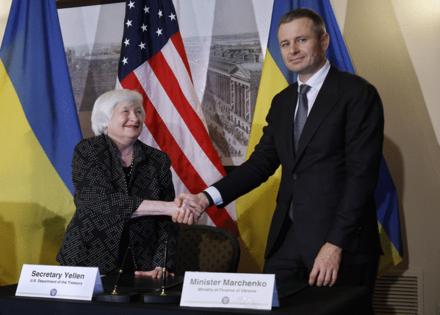G7 agrees to use interest on Russian assets for Ukraine loan; Biden eyes an arms component
Published in News & Features
WASHINGTON — The Biden administration said Wednesday it would provide a $20 billion loan to Ukraine, concluding an aid agreement reached in principle by the G7 leading industrial nations in June that relies on interest from roughly $280 billion in frozen Russian state assets to support Kyiv.
The $20 billion loan — dubbed an extraordinary revenue acceleration loan by the administration — is part of a $50 billion Western package to help Ukraine in its war against Russia. The remaining $30 billion will come from from the European Union, the United Kingdom, Canada, and Japan and other partners.
“This loan initiative will provide Ukraine with urgently needed funds and will make funds available by the end of this year,” Treasury Secretary Janet L. Yellen said at a signing ceremony Wednesday with Ukrainian Finance Minister Sergii Marchenko. “It will send a message to (Russian President Vladimir) Putin that waiting out our coalition is a losing strategy.”
The U.S. loan will include at least $10 billion in economic assistance given to the Ukrainian government through the Financial Intermediary Fund (FIF) that the World Bank established for Ukraine this month.
Daleep Singh, the White House deputy national security adviser for international economics, said the administration hopes to provide the remaining $10 billion in new security assistance but Congress would have to authorize by mid-December an increase in the State Department-administered Foreign Military Financing for Kyiv and to make certain related technical changes to allow it as military support. He said Washington would provide that $10 billion as economic assistance if Congress doesn’t act in time.
“Nothing like this has ever been done before,” said Singh. “Never before has a multilateral coalition frozen the assets of an aggressor country and then harnessed the value of those assets to fund the defense of the aggrieved party, all while respecting the rule of law and maintaining solidarity.”
Speculation is widespread in Washington and European capitals over how much longer Western democracies will be willing to finance Ukraine’s defense after two-and-a-half years of incremental military gains and losses.
The Biden administration has made it a priority to lock in the $50 billion before the president’s term ends on Jan. 20. Republican presidential nominee Donald Trump has declined to say whether he would support Ukraine. If he wins the election in two weeks, the outlook for U.S. military and economic aid would likely dim, as would Europeans’ confidence that they can prop up Ukraine alone.
The U.S. economic loan to Ukraine will fund repairs ahead of winter to the energy grid, which has been under regular attack by Russia, and to improve protections of the grid’s substations and transformers against drone attacks, Singh said.
Some European governments needed months of prodding to agree to use interest on Moscow’s frozen foreign currency reserves — about $200 billion of which is held in Belgium — to finance the loans. Lawmakers on Capitol Hill have called for Belgium and other foreign partners to seize and liquidate all of the Russian assets and transfer the proceeds to Ukraine.
The U.S. holds just $5 billion in frozen Russian sovereign assets.
“Multilateralism is a force multiplier. We couldn’t have done this by ourselves,” Singh said. “This is another example of how Putin’s war of aggression has unified and strengthened the resolve of G7 countries and our partners to defend shared values.”
_____
©2024 CQ-Roll Call, Inc., All Rights Reserved. Visit cqrollcall.com. Distributed by Tribune Content Agency, LLC.







Comments